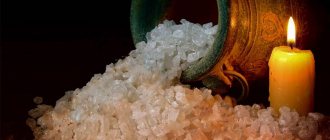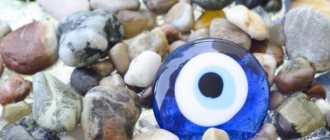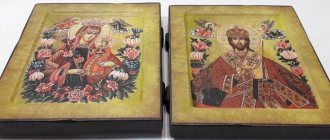Thursday salt is salt that can be prepared only once a year, on Maundy Thursday. Since ancient times, Christians have endowed this product with magical qualities; it was believed that it protects against the evil eye and evil spirits, and is endowed with the ability to treat many diseases.
Thursday salt has many advantages over sea or table salt, and miraculous properties are attributed to it due to the fact that it is made on a special day for Christians, Maundy Thursday during Holy Week, when a person’s soul is cleansed of all bad things.
Thursday salt is almost a sacred product among Christians
Thursday salt - what is it?
What is Thursday salt? It is one of the most powerful and important amulets for Christians. It was made only on Maundy Thursday during Holy Week.
Initially, they learned how to burn a healing amulet in Kostroma, where among local residents it was a custom before Easter to heat white crystals in an oven with the addition of various products - rye bread, flour, cabbage leaves.
The product made by kiln firing is black in color. The color change is due to the effect of high temperature on the salt crystals, due to which the impurities of heavy metals evaporate, which makes the salt purer and healthier.
The unusual black color is one of the reasons why the spice is considered magical and healing, but the whole point is only in a chemical reaction, and not in the magic of Maundy Thursday.
The product turns black
The magical properties of salt
Salt is susceptible to various types of energy. The necessary information can be added to the crystals to achieve goals. In Rus', the seasoning was used as a talisman for travelers. According to legend, charged crystals could ward off evil spirits and protect against the evil eye, damage, envy, and curses.
Not every type of salt is suitable for magical work. You should not use material containing various impurities - iodine, dyes, flavors.
To carry out the ritual, it is advisable to buy seasoning rather than use the one available in the house. The crystals, which had been in the apartment for a long time, managed to receive this or that information that would interfere with their work.
Where is Thursday salt used?
The use of Thursday salt is associated with various Christian beliefs, which endowed this product with strong magical and healing qualities.
Ways to use black spice as a protective amulet and traditional medicine:
- A pinch of crystals is added to babies' bath water to protect them from illness and the evil eye.
- When a child is baptized, a little salt is placed in his ears to protect him from damage and evil forces.
- A jar of seasoning that needs to be placed on the table attracts prosperity and prosperity to the house.
- A bag of black crystals pinned to clothing will bring good luck on your trip.
- To protect the family from squabbles and quarrels, a bag of food is always kept in the bed under the pillow.
- To preserve youth and beauty, salt is added to the water for washing.
- At a wedding, black crystals were served along with a loaf of bread - this will promise reliability and longevity to the marriage.
- To ensure that there was always peace and mutual understanding in the house, black crystals were scattered in the corners of the living rooms.
In Siberia, the spice, burned on Maundy Thursday, was mixed with grain before sowing. This was done in order to ensure a rich harvest. When livestock became ill, Christians added black crystals to the animals' food, believing that the salt would help heal them.
What else can you do with Thursday salt? Of course, add it to various dishes. Kiln-fired crystals have a pleasant soft taste and are enriched with mineral elements
Salt, which will be used as a seasoning for dishes, can be additionally sifted to make it purer. But at the same time, the remaining ash particles give the crystals a soft taste.
As a seasoning for dishes, black salt is preferable to table or sea salt, since it does not contain harmful impurities, it has a milder taste and a lower degree of salinity.
Can be used as a regular seasoning
Conspiracies with black salt
If your health deteriorates, add a pinch of crystals to a glass of water and say:
“Just as fire tempered salt, so the body (say the name) is filled with health. Amen".
Next you should drink water.
If life’s misfortunes have overtaken you, scatter spice in the corners of the house, saying, “Go away, trouble, go away. Amen".
If a bad person came to the house, after he left, you need to pour salt on the road in the direction where the ill-wisher went and read the “Our Father” three times.
When preparing dishes with the addition of black crystals, you need to take into account that they are less salty in taste than regular table salt.
Useful properties of the product
Christians believed that consuming black spice could not only protect against illnesses, but also cure many diseases. The benefits of salt are explained by the presence in its composition of a high content of elements such as magnesium, potassium and calcium, and a minimal concentration of harmful heavy metals.
Product benefits:
- saturating the body with macro- and microelements, which are present in high concentrations in the product;
- cleansing the intestines with regular use of black crystals;
- healing of damaged mucous membranes;
- improvement of digestion processes;
- elimination of inflammatory processes.
Diseases and pathologies for which black crystals are recommended to be used as food:
- diseases of the digestive system;
- abnormalities in bowel function;
- weak appetite;
- osteochondrosis;
- obesity;
- frequent constipation;
- bloating and increased gas formation.
In folk medicine, salt dressings are made based on Thursday salt, which help with various diseases.
The therapeutic effect of the product is explained by the fact that salt is an active adsorbent product - it is capable of drawing out various pathogenic microorganisms, viruses and microbes from the body, which provoke many diseases.
Useful black spice can be bought ready-made, depending on the degree of its purification; the product can be used as a seasoning for food and for medicinal purposes, for example, for salt baths or dressings for various inflammatory processes.
You can buy this salt
The use of black salt in food should be careful - its excessive consumption can provoke severe fluid retention in the body. It is necessary to use black crystals carefully when cooking if you have the following health conditions:
- tendency to edema;
- diseases associated with circulatory disorders;
- diseases of the kidneys and urinary system;
- high blood pressure.
The nutritional feature of black spice is the taste of hydrogen sulfide. But since little of it is added to food, this flavor nuance goes unnoticed.
The safe amount of salt to eat is ½ teaspoon per day.
Meaning
Everything that surrounds us was created for the sake of people. Adam and Eve needed a clean environment. As a result of the Fall, everything was lost and came under the dominion of Satan, but God's providence of salvation was primarily focused on the salvation of mankind. True Parents became the first true couple in history. Until the position of True Parents was finally established, God could not seriously begin to restore everything.
According to the Principle, True Parents are the perfect ideal man and woman and the progenitors of humanity, whose life is centered on God. Just like Adam and Eve, they needed an ideal environment. After True Parents' Holy Blessing, the environment was not yet ideal. Therefore, to sanctify the environment and all things, True Father created Holy Salt.
At the meeting held after his Blessing, the Father gave each of the parishioners present a portion of Holy Salt, explaining that any item once blessed with Holy Salt would no longer belong to Satan's dominion and would instead come under the dominion of God. Because of our faith in True Parents and based on their foundation of defeating Satan, Holy Salt affects objects the same way no matter who the Unification Church member uses it.
The “New Heavens and New Earth” spoken of in the Bible actually originates from the time of the Holy Blessing of True Parents. When we use Holy Salt, we become participants in building the Kingdom of Heaven on earth. From a providential point of view, whenever we use Holy Salt, we are entering into battle with Satan. We take things from the satanic world and ask God to take them under His dominion.
Members of the Unification Church should understand that it is a great privilege to have Holy Salt at their disposal. Every parishioner should understand its significance. As we strive to live a spiritual life, each of us desperately struggles to be freed from Satan. By using Holy Salt in the simplest way, we gain some measure of this freedom.
The Father emphasized the importance of Holy Salt in his speech entitled “Seven Day Fast”, delivered on October 24, 1974:
“It was not God's intention that His children should use things and eat food that had been tainted by the rule of Satan... God allowed me to create Holy Salt to sanctify all these things, to make them fit and pure enough for His children to use... The value and meaning of Holy Salt in to uproot, destroy or destroy everything satanic; In addition, by using Holy Salt, you yourself undergo a process of sanctification.
Those gathered here were probably unaware of the importance and value of Holy Salt. From now on, you should feel the need to always have Holy Salt with you. Until now you have not understood this.”
Material selection
The father had to choose a substance that could conditionally cleanse and sanctify objects from the satanic world and spiritually make them holy, without changing their appearance. Since salt is considered a traditional preservative that protects food from spoilage, it was what Father chose.
How long will this tradition be practiced?
Once Heavenly Dominion is restored to a country, all worshipers living there will no longer need to use Holy Salt; all things will be automatically sanctified. However, until all of humanity and all things in the entire world completely come under God's dominion, despite the establishment of Heavenly dominion in one country, the use of Holy Salt will continue.
Preparing Thursday salt
The Thursday amulet can only be fried using table salt with large crystals. Sea, fine or iodized salt are not suitable for this purpose. You can roast the product on a baking sheet, in a thick cauldron or in a frying pan with a thick bottom.
To prepare the product in the apartment, just sprinkle table salt on a baking sheet and put it in the oven, but if you have the opportunity to fry it in the oven, this is the best option, because this is exactly how, with ash particles, you will get real Thursday salt.
Real Thursday salt must have ash
The prerequisites for making black salt are the absence of bad thoughts and a good mood. To enhance the magical characteristics of the product, it is recommended to say a prayer while frying it:
“Just as this salt becomes pure, and evil spirits will not stick to it, so neither adversity nor shame will stick to my house. Amen".
Recipes
There are several simple and complex recipes.
Simple frying with flour
The first and simplest method of frying salt with the addition of flour:
- Ingredients - 10 tbsp. l. coarse table salt and 1 kg of flour.
- Salt is poured into the frying pan and flour is added to it.
- When heating the ingredients, they must be mixed with a wooden spatula or spoon, strictly clockwise. While stirring, the “Our Father” is read three times.
- Fry the salt until it turns black - this color means it is completely ready.
The degree of ash content and blackness of salt crystals can be adjusted. The more flour you add, the richer the color will be, since flour, under the influence of high temperature, turns into tiny coal particles.
Recipe with rolled oats
You need to do this:
- Hercules is filled with water. Salt is added to the resulting mixture in a 1:1 ratio.
- The ingredients are mixed until a mixture is formed that is similar in consistency to sand.
- The resulting mixture is laid out in a pyramid on a piece of linen fabric, the ends of which are tied with a rope. Leave the mixture for 2-3 hours.
- Unfold the fabric, place the mixture on one edge of the fabric, cover with the other side on top and roll with a rolling pin several times to form a “sausage”.
- Wrap the “sausage” of salt and rolled oats in linen cloth, tie it tightly with twine and place the bundle in hot coals. Bake overnight with the oven damper closed.
The burnt spice comes out in a big lump, but that’s how it should be. The lump then needs to be crushed and scattered into bags.
After frying, the salt will appear in large clumps. They need to be crushed, but since this is not so easy, you will need a hammer.
If the product is to be used as protective amulets, the crystals can be left quite large, and if used as a seasoning, the salt must be ground to a sandy state.
Large lumps are suitable for amulets
Salt with rye bread and herbs
Interesting recipe:
- Ingredients: 1 kg of white spice, rye bread, preferably home-baked, and a mixture of herbs. The herbal mixture should include St. John's wort, thyme and wormwood, pine and juniper. Herbs are crushed in a mortar.
- The bread is soaked in water, then crushed and mixed with salt and herbal mixture.
- The resulting mixture is laid out on a baking sheet and placed in a preheated oven or oven.
During frying, the mixture can smoke heavily, so you need to turn on the hood in advance and open the windows wide.
bread loaf
Another method is with a loaf of bread:
- A brick-shaped loaf of bread is cut into two parts.
- The crumb is removed from the cut bread, and salt is added instead.
- Place the crumb back on top of the spice and cover one part of the bread with the other half.
- Place the bread in the canvas and tie it tightly with twine.
- Bake in the oven for 8 hours in the residual heat from the coals.
Fired crystals do not accumulate moisture and can be stored for a year. For storage you need to use small linen bags.
With cabbage leaves
Cooking method:
- Remove leaves from fresh cabbage and chop them;
- mix leaves with rock salt;
- place the ingredients on a baking sheet or in a cauldron and place in the oven;
- When the ingredients become dark, remove them from the oven; after cooling, grind them to restore the free-flowing consistency.
With kvass grounds or with the addition of Borodino bread
The cooking algorithm is as follows:
- mix 1 kg of large crystals with kvass grounds, which can be replaced with 5 kg of Borodino bread softened in water;
- place the mixture in a frying pan with a thick bottom and place in the oven preheated to 250 °C;
- after the leaven grounds or bread have blackened, remove the pan from the oven;
- After the product has cooled, it must be ground through a sieve.
The ancient Slavs most often used 2 methods of production - in bread or with herbs.
The greatest value as a medicinal remedy is the spice, burnt with herbal mixture; it is rich in minerals and essential oils
Black salt has a protective, cleansing and healing effect. For a long time, healers have used this product both for treatment and for protection against the evil eye. It is prepared only on Maundy Thursday, the day when a person is cleansed of everything bad and negative. Black crystals are a powerful amulet, a tasty and healthy addition to various dishes, and an effective means of traditional medicine.
Uses of Holy Salt
Prayer
There is a traditional prayer that is said during the consecration with Holy Salt. Pray like this: “I consecrate this item in the name of the Universal Parent, in the name of the Parents of heaven and earth, in the name of the families of True Children, and in the name of [your name], the owner of Cheon Il Guk.”
Process
After the prayer, sprinkle the object with Holy salt two or three times in a cross pattern from north to south, then from east to west. If the object is small, it is enough to simply sprinkle it three times, imagining that you are doing it in the shape of a cross (Fig. 17.4).
Take Holy Salt and bless objects with it only with your right hand.
Storing Holy Salt
To ensure safety, Holy Salt can be stored in a tightly closed container (jar) with a lid, but this is not a strict requirement. Beautiful jars or vessels with ornaments are often used to store Holy Salt; they can also be placed on the altar.
It is good if every branch of the Church or every blessed family has at least one container of Holy salt in a public place (for example, in the kitchen) to consecrate various things brought to church or home.
Keep the first Holy Salt given to you
Each parishioner should keep at least a small amount of the Holy Salt that was given to him for the first time (either after joining the Church, or after he first understood its meaning). This Holy Salt should be kept separately and should not be used to consecrate objects in daily practice. If the supply of Holy Salt given to you for the first time is large enough, it can be used little by little as the original Holy Salt for multiplication.
Carry Holy Salt with You
Father suggested that it would be good to carry a portion of Holy Salt with you. Since this is necessary in order to always be able to use Holy Salt if necessary, it is advisable that it is not the same Holy Salt that you first received.
If desired, you can pour Holy Salt into a very small box (or plastic jar) that closes tightly.
Eliminating the effect of consecration with Holy salt
Sale of property or assets
There is no official method for eliminating the effect of Holy Salt's consecration. As mentioned above, in the prayer during consecration with Holy salt, it is necessary to clearly indicate that consecration is conditional and is valid for a certain period of time.
If, during the consecration after the purchase, the prayer did not say about the temporary nature of the consecration, and, nevertheless, the property needs to be sold, a special prayer must be offered. In prayer, it is necessary to explain that despite the fact that the property was sanctified with Holy salt, there was a need to sell it. The reason must be explained (for example, money is needed for other purposes, or the premises have become too small and cannot fulfill its purpose, etc.).
Donation of personal property
If a parishioner donates his clothing, furniture, other personal property, etc. for an “external” organization (an organization that is not part of the Church), and during the initial consecration of these items the prayer did not say about the temporary nature of the consecration, a special prayer must be offered before donating items. In this prayer, it is necessary to explain that, despite the consecration with Holy salt, due to certain circumstances (name these circumstances), this property should be donated to someone.
Items returned to the store
When items have been purchased and blessed with Holy Salt for use, but for some reason it becomes necessary to return them to the seller, prayer should be offered as to why the items have to be returned (see the instructions described in the previous two paragraphs).
History of origin and beliefs
In Slavic folk beliefs, salt is a symbol used mainly as a talisman. Salt, according to popular belief, can protect against hostile forces and influences. The “Thursday salt” prepared on Maundy Thursday was endowed with special powers. This is no coincidence: Maundy Thursday in folk life was associated with the performance of many different rituals designed to ensure well-being in the family and household for the entire coming year. Among the Eastern Slavs, Holy Thursday was almost universally called Clean Thursday. The cleansing rites of Maundy Thursday concerned not only the person himself, but also his immediate environment, primarily his home and utensils. At dawn on this day or on the eve of it, the housewives washed and scrubbed the floors, walls, ceilings, tables and benches, cleaned the icon lamps, steamed milk dishes, shook the straw from the beds, etc.
In addition, superstitious veneration of the “passionate” or “Thursday” candle, bread, and salt was widespread among the people; healing powers were attributed to them.
“Thursday” salt was stored throughout the year. It was used against the “evil eye” and as a universal remedy for the treatment of a variety of diseases (both in humans and in domestic animals). The peasants took it internally, rubbed it with its solution, and gave sick cattle bread salted with it or diluted a pinch in a drinking bowl. As a talisman, “Thursday” salt was sewn into an amulet and worn on the chest.
Need I say that the folk customs listed above, from the point of view of Christian doctrine, are superstition, often blasphemous? The surviving pagan beliefs in many cases did not change their essence, although they were associated in the minds of the people with church holidays, events and persons of Sacred history. Likewise, the preparation of “Thursday salt” has nothing to do with the real traditions of Orthodoxy .
Let's now talk about church practice itself. In the Trebnik there is a prayer for the consecration of salt - “Prayer over salt.” Prayer over salt is one of the oldest... In the spiritual sense, salt means the saving teaching of Christ and the holy life of His preachers (Matthew 5:13).
The New Testament Church uses salt for the bread offered as a bloodless sacrifice and blessed at all-night vigils. The Church also blesses salt as an essential food product. But in the liturgical books there is no indication of the need to consecrate salt on any specific day of the year. In S. V. Bulgakov’s “Handbook for Clergy,” we also will not find instructions for the consecration of salt either on Maundy Thursday or on Easter.
So, the popular belief in the healing power of “Thursday salt” goes back to pre-Christian mythological ideas and is in no way connected with the church “prayer over salt”. But remnants of paganism existed among the people. The clergy also could not help but experience the influence of the people (especially since in terms of the level of theological education they were often almost no different from them). There are cases in the history of the Church when the clergy accepted the pagan beliefs of parishioners. Thus, at the beginning of the 4th century, the Council of Elvira (in Spain) with its 34th rule prohibited lighting candles in a cemetery during the day - “so as not to disturb the souls of the saints.” Sometimes even the clergy is able to follow the lead of the beliefs of parishioners, while transgressing the gospel and patristic commandments. Let us make a reservation, however, that such cases are very rare, since the Church has always sharply resisted attempts to “sanctify” superstitions with its authority.
In relation to “Thursday salt”, such attempts have already happened. In the 16th century, numerous superstitions prevailed everywhere, not only among the common people, but also among the upper classes and the princely family. This is evidenced by the Council of the Hundred Heads, held during the reign of Ivan the Terrible (1551): “On Great Thursday they burn straw and call out the dead; Some neveglas [ignorant] priests put salt under the throne on Maundy Thursday and keep it there until the Seventh Thursday after Velitsa [Easter] and give that salt for healing people and livestock.”
In those days, traditional medicine consisted entirely of spells and magic remedies. National and private disasters, failures, family discord, etc. were constantly attributed to witchcraft, and witchcraft was the means to eliminate them. The spirit of magic penetrated into the very Christianity of the people. Conspiracies received a Christian form, replacing in their appeals the names of mythical forces with the names of saints; on the other hand, some Christian prayers turned into conspiracies through the communication of magical powers to them in the popular consciousness; lists of them were worn around the neck, kept in homes as talismans, and used in witchcraft. Magicians used even sacred objects for their own purposes, for example, they cast mallow cups over prosphora,... priests... placed a child’s afterbirth on the altar for 6 weeks in the church. Various fortune-telling notebooks passed from hand to hand - Rafli, Aristotle's Gate, Six-Wing. Since the 16th century, astrological superstitions and fortune-telling have come to us from the West, placed in Ostronumey, Zodey, Almanacs... But you need to be careful and remember - these are all deviations and paganism.
And yet, under these conditions, the Council of the Hundred Heads (1551) showed enough Christian wisdom to reject a number of attempts to penetrate superstitions into the church environment, and among them was the indicated unique method of obtaining church “sanction” for “Thursday salt”. The resolution of the Council on this matter read:
“The commandment is that on Maundy Thursday they should not burn straw and not call the dead, and priests would not put salt under the throne on Maundy Thursday, and they would not keep the days until the Seventh Thursday in Velitsa, since such is Hellenic charm and heretical blasphemy. And whoever does such a priest will be subject to excommunication and final eruption according to the sacred rule.”
Oddly enough, “Thursday salt” is becoming popular again these days. At the same time, superstitious people, convinced of its miraculous power, again seek to win the Church over to their side. This causes understandable confusion among parishioners:
“In our city there is a convent next to the temple. And so on Thursday, in the last week of Lent, during the service, the nun brought salt in a plastic bag, the priest came up and read prayers. The parishioners standing nearby also took a handful of this salt from the bag, for which the abbess scolded the nun. And when the next year my sister and I came on the same day (Thursday of the last week of Lent) with the hope of also consecrating salt, nothing like that happened. I asked one of the nuns about this, she replied that this was the first time she had heard about the consecration of salt, that she had never seen or heard anything like this. So what is Thursday salt, what is it used for?”
, asks a participant in one of the Orthodox Internet forums.
The priest rightly remarks in response:
“I don’t know who elevated this salt to the rank of a special shrine (in the missal there is a prayer over salt, but this is not the consecration of the pure Thursday salt, but simply a prayer, similar to the prayer for the blessing of livestock, sowing and vegetables). Now this custom is becoming popular in some parishes and monasteries, but this is nothing more than an unauthorized innovation . You can approach this in different ways - you can read a prayer over salt, you can bring it on a certain day for consecration, too. However, it is strange to attribute to her any special healing power or grace. The use of this salt is limited to cooking only, so it is nothing more than blessed salt from the temple. The healing properties attributed to it remain on the conscience of the distributors of these stories. By faith, of course, there can be healing from salt, but we have holy water, other shrines... And, finally, Holy Communion!”
Hegumen Alexander (Pakhomov) writes on the Orthodox forum:
Thursday salt brings together several church and everyday images associated with salt. Salt is the only nutritional element that cannot be replaced and it is the only mineral consumed in food and also a powerful preservative. The Gospel gave us the image of salt, as an image of a believer: “You are the salt of the world.” Another interesting image is from the Old Testament - Lot’s wife, who turned into a pillar of salt and through this, as if stopped in her sin.
It is customary to prepare all the best for Easter: church vestments, your clothes, food. In ancient times there was no grinding and salt was often sold in large crystals or pieces. The salt was burned in ovens at home so that it crumbled into powder, i.e. became the best. Wednesday and Thursday are the days when preparations for breaking the fast began, and salt was probably prepared for the festive table at the same time.
In superstitions, evil spirits usually live in damp and dark places, where food spoils quickly, and salt can protect against rot (spoilage). Look carefully at the “protection” from the “undead”: silver, garlic, salt - preservatives and antiseptics. Apparently they once decided to fight spirits, as well as mold and germs.
In the missal there is a prayer for the consecration of salt, but there is no indication of a specific date (bless at least every day) and there is only one request in it - to offer it as a sacrifice of joy, apparently because without salt, food is not food, but not a word about it "fighting" qualities.
It is better to fight “ill-wishers” not with bags of salt, but by fulfilling the gospel virtues, and, as you know, demons are driven out not by garlic, but by fasting and prayer.
And somewhat off topic. The Internet has absorbed the principle of tolerance, so do not pay attention when you see the Cross of Christ and magical symbols nearby. Even in the store, you take only what you need, and not everything in a row.
The Lord Jesus Christ says: This generation does not come forth except through prayer and fasting (Matthew 17:21). Therefore, prayer, that is, invoking the name of God, God’s help, and fasting are the main means in the fight against the invisible enemy. There is constant invisible warfare, spiritual warfare. And fasting is precisely the time favorable for that struggle, for the correction of one’s soul. By fasting, everything helps this, and for fasting the special grace of God is given. And we usually all hold unction during Great Lent. Therefore, when they say: “Food is not the main thing,” we must remember that in order to get to the main thing, you need to start at least from a small step. And physical fasting is the first step. Conceit and human pride say: “It doesn’t matter, the main thing is not to swear.” Yes, I agree. So, if you fast, there will be no more reasons to swear, even this will help” (Archpriest Valerian Krechetov) (1).
“Whoever rejects fasting forgets what caused the fall of the first people (from intemperance) and what weapon against sin and the tempter the Savior showed us when he was tempted in the desert (fasting forty days and nights), he does not know or does not want to know that a person falls away from God most often through intemperance, as was the case with the inhabitants of Sodom and Gomorrah and with the contemporaries of Noah, for from intemperance every sin in people occurs; whoever rejects fasting takes away from himself and from others weapons against the multi-passionate flesh and against the devil, who are strong against us especially through our intemperance, he is not a warrior of Christ, for he throws down his weapon and voluntarily surrenders himself into captivity of his voluptuous and sin-loving flesh; he is finally blind and does not see the relationship between the causes and consequences of affairs"
, - Righteous John of Kronstadt).
Thus, “Thursday salt” is a pagan superstition . Its preparation and use are magical manipulations that contradict church teaching. Orthodox Christians should remember the words of the Apostle Paul, who warned against following empty deception, according to human tradition, according to the elements of the world, and not according to Christ (see: Col. 2:8):
[Zach. 254.] Take heed, brethren, lest anyone lead you away with philosophy and empty deception, according to human tradition, according to the elements of the world, and not according to Christ; for in Him dwells all the fullness of the Godhead bodily,
Practical Applications of Holy Salt
Purchases
Everything that is purchased for personal use, for family or for the Church - food, clothing, furniture, appliances, etc. - must be blessed with Holy Salt immediately after you bring it to church or home.
Present
Use Holy Salt to bless gifts not received from Church members. You may also be tempted to dedicate a gift you received from another parishioner, unless the giver warns you that the gift has already been consecrated.
If you give something to a person who is not a parishioner of the Church, then the gift does not need to be blessed. However, this can be done if desired. True, in this case, during consecration, it will be necessary to clarify in prayer that the gift will be given to a person not from the Church.
Own things
When someone comes to live at the Church's training center, that person's personal belongings must be blessed with Holy Salt. It is not necessary to consecrate each item separately. It is enough to consecrate only a few things that will symbolically represent the entire property. This only needs to be done once. After moving to another training center, the property does not need to be rededicated.
From this moment on, the parishioner must sanctify all purchases with Holy Salt.
When members accept the Divine Principle and come to understand the meaning of Holy Salt, they should begin to sanctify purchases of Holy Salt. Their personal belongings and home (apartment) can also be blessed with Holy Salt (for example, symbolically, as explained above).
Rooms and other premises
The following is a description of the rules for using Holy Salt to consecrate the main room(s) in a building purchased by our Church. However, this method is also suitable for other occasions when an area needs to be sanctified or cleansed (for example, if there is a low spiritual atmosphere, or in preparation for a Three Day Ceremony or an Eighth Day Dedication Ceremony).
Stand in the center of the room facing north with the Holy Salt in your right hand. Say the basic prayer described in the section “Using Holy Salt: Prayer,” replacing the words there as necessary.
Throw a pinch of Holy Salt on the north wall of the room. Then throw salt on the south wall, and then on the east and west. After this, sprinkle Holy salt from the center of the room in a circle, which will symbolize the consecration of the room completely (Fig. 17.5).
Use Holy Salt to consecrate a special part of the room (such as where the altar will be located) in the same way.
Buildings or other property
Buildings or other property purchased by our Church or parishioners should be blessed with Holy Salt as soon as possible, especially if the Church begins using it immediately (unless it is rented to someone else).
Regardless of whether a building or other property remains the property of our Church, it must be blessed with Holy Salt. However, in the case of temporary (albeit long-term) use, a “conditional prayer” must be said during consecration (see the section “Removing the effect of consecration with Holy salt” in this chapter).
Building
When consecrating a building purchased by our Church with Holy Salt, the process described below must be followed.
When consecrating a large house or an entire building, there is no need to follow the same rules as when consecrating a room (which was described in the previous section), and consecrate room by room. Perform the dedication ceremony only in the main room(s), and symbolically dedicate the other rooms. Simply open the doors of other rooms and, with the same inner attitude as when consecrating the main room, throw a pinch of Holy Salt at the entrance to the room or a little deeper 2 or 3 times.
When consecrating a house or building, walk around the outside of it (if possible, around the entire perimeter), throwing small pinches of Holy salt on the ground along the way.
Note. In principle, we should not plan to sell any property purchased. However, if there are circumstances that justify such a plan, then at the consecration, include in the prayer these words: “Consecrate this building (property), and let it remain consecrated until our Church sells it.”
Land area
When consecrating the territory (area) with Holy salt, if possible, walk around its perimeter, throwing pinches of Holy salt along the entire path of the walk. If the area covers many acres (1 acre = approximately 0.4 hectares) and it is difficult to cover it all, go to the center of the area and, following the directions given in the "Rooms and Other Areas" section, dedicate the area conditionally, following the basic instructions.
Rented premises
House or apartment
It is also very important to conditionally consecrate things (premises) that are used by parishioners, but are not the property of the Church. Therefore, when renting a house or apartment, bless it with Holy Salt (as described above) before moving in. In the prayer, it is important to mention the conditionally limited rental period, for example: “Separate from Satan and sanctify this apartment/house for the time we use it. Please make this place a conditionally holy place and take it under Your dominion until we move to another place.”
Motel or hotel room
Use Holy Salt to bless any motel or hotel room. It is very important that this consecration be conditional. Refer to the previous subsection for the approximate content of the prayer. Say in prayer that the room should be consecrated only for the period of your residence in it.
You can then follow the instructions given in the “Rooms and other premises” section.
Enterprises, companies and offices
Holy salt should be used to bless the premises and offices of businesses owned by the Unification Church, even if they employ more than just members. If someone (a parishioner of the Church) is hired to work in a company not associated with the Church, then he can, if he wishes, consecrate some things there. In this case, you need to do this carefully and pray for the consecration of objects only for the time of your immediate use.
Business enterprises should not consecrate items that will later be sold to the public.
Consecration of a house or room where a low spiritual atmosphere is felt
In the same way as described in the previous section, Holy Salt can be used to uplift the low spiritual atmosphere of a room.
How to bless table salt
To create illuminated salt, we will also use ordinary table salt, as in the first case. The rite of consecration of salt is carried out over three days.
On the first day, heat the salt by pouring it into a frying pan and placing it on an open fire. The salt needs to be heated for thirty minutes. Then, while the salt is still hot, it must be poured into a storage container, preferably made of natural material (wood, ceramics). Before doing this, place gold jewelry at the bottom of the container (gold should be of the highest standard) and leave it like that until the next day.
On the second day, take your gold out of the salt and again set the salt to heat over the fire. This time we “fry” the salt for twenty minutes. Then pour the salt back into the storage container, putting silver jewelry there (silver should also be of high standard - it is not advisable to put silverware).
On the third day, remove the silver from the cup of salt and let it heat for the third time for ten minutes. Then, while the salt is cooling, stretch your hands over the bowl and feel the warmth emanating from it. Hold your hands over the salt for ten minutes, trying to breathe slowly and evenly. Now the salt is completely ready.
Effect of Holy Salt
For things and objects
Holy salt is an effective tool for Unification Church members to use against the satanic force in our environment. Our final separation from Satan's dominion will depend on our attitude towards life. Each of us must try to win an internal victory, and it is not achieved only by creating external conditions.
Until blessed with Holy Salt, purchased goods cannot be accepted into the dominion of God. The food most likely did not come from a farm that God can take over, and the clothing most likely came from a factory that God cannot claim as His own. Despite this, we still have to use things from the satanic world. Therefore, God can accept into the sphere of His dominion the things we buy, which are sanctified with Holy salt.
Although the consecration of objects with Holy Salt may seem like a purely external ritual, the meaning of Holy Salt is such that it allows the consecrated things to become the property of God rather than remain part of Satan's domain.
Products grown in the domain of the Church
In principle, there is no need to sanctify food grown on a farm that is owned by the Church and operated by Church members. All seeds have already been blessed with Holy Salt upon purchase.
On people
Although Holy Salt is a condition for separating things and environments from Satan's dominion, it does not separate people from Satan's dominion. It cannot provide a person with fundamental inner cleansing and should not be used to “cleanse” anyone upon entering a Church premises.
However, if a parishioner feels strongly influenced by the forces of Satan after being in a spiritually low environment, he can sprinkle himself with Holy Salt. Although this will not cleanse a person, it may help him feel that his garments have returned to the realm of God's dominion and that he is no longer tied to or dependent on Satan's environment.
Should black salt be sanctified?
There is no clear answer. The preparation of Thursday salt at home is timed to coincide with the great holiday of Easter. There is a special prayer for consecration. But the Orthodox Church does not support such a tradition; it interprets it as having pagan roots.
But people continue to believe that it is not enough to bake the medicine, and then crush and sift. The obligatory final step is consecration in the temple.











